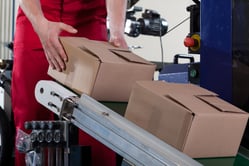
According to a global survey conducted by SYSPRO to understand how manufacturers and distributors handled the operational shifts brought on by COVID-19, more than half were impacted by supply chain disruptions. In addition, 47 percent of businesses were unable to function due to reliance on their on-premises operational staff. And nearly a third felt that their business systems did not provide them with the availability and accessibility to manage the changes the pandemic introduced.
As businesses continue working to stabilize, many are considering adopting emerging technologies and industry 4.0 to mitigate the impact of major disruptions in the future. The challenge for many, however, is understanding which technologies and manufacturing systems to adopt and when to pursue this transformation.
There are a number of technologies poised to make a positive impact on manufacturing and distribution in the next five years. Which manufacturing systems are you looking at implementing?
Automated Warehouses
Transitioning to an automated warehouse won’t happen overnight. Fortune 500 companies began this journey years ago and have the added benefit of billions to put toward automating their warehouses. But most manufacturers don’t have the big budgets to make this happen.
Automating your warehouse is a long and expensive journey, but also an important one. The key to success is to start planning now, as it will take three to five years for most organizations to be fully automated. Even at full automation, the warehouse will still be approximately 65 percent staffed.
Automation augments human capital, especially in smaller manufacturing plants; it doesn’t replace it. Due to the global pandemic, there’s more of a push for robots to fill a more autonomous role to decrease the possible transmission of disease, for example, but initial steps are small. The industry is a long way from a fully robotic scenario with remote monitoring.
Contactless Payments
Globally, through this pandemic, many manufacturers started their shift first with online shopping, then contactless delivery. In some instances, they used robots to enable social distancing. Additionally, the industry saw increased implementation of digital and contactless payment, with many retailers upgrading credit card payment systems to allow for tap to pay.
One of the first areas manufacturers can make changes is in reducing paper-based systems, particularly at the point of delivery. Different countries have attempted various solutions, from robot baristas to grocery services delivering food from vans to front doors using robots, eliminating the need to sign for delivered goods and services, all in efforts to comply with governmental regulations and safety recommendations.
Automating to a paperless manufacturing system is easier than you might think. ERP systems can help automate the process, which is easily facilitated by smartphones and tablets employees already own. For smaller manufacturers especially, the advent of “bring your own device” (BYOD) means there won’t be a huge outlay for specialist devices, making this an affordable way to start the digital transition.
Ecommerce
Another way organizations were transitioning during lockdown was taking their businesses to the cloud to facilitate work-from-home environments and to allow for more agile online shop fronts where orders could be automatically captured and processed.
During the pandemic, many organizations have had to upgrade their online presence to enable ecommerce. Manufacturers who had the foresight to move their technology forward a year or two ago and upgrade their ERP systems were able to easily plug in payment gateways, which made a big difference for their businesses, especially as order volumes increased.
The ability to also plug into a connected supply chain and make use of an established third-party system for the retail and distribution of their products also proved a winning combination. This enabled businesses to extend their individual supply chain through a connected supply chain and remain agile in the face of a global impact event.
Additive Manufacturing
Another financially attainable manufacturing system that has advanced innovation and had a major impact in the sector over the past year is additive manufacturing, more commonly known as 3D printing.
Prior to 3D printing, a part would be designed using a CAD drawing, then sent to a plastic mold injection company who would create a prototype. Today, businesses can add 3D printers onsite so that product innovators can send a piece from CAD to the 3D printer for immediate creation. This advancement adds significant time savings by rapidly moving concepts to manufacturing. In fact, auto manufacturers began 3D printing critical ventilator parts at the peak of the pandemic.
Boost Manufacturing Systems With PositiveVision
The key to planning any transition is to look at immediate needs and choose manufacturing systems that can help unlock the most value. Don’t get locked into one technology; use connected systems that best suit the business, enabling you to jump from capturing orders at your desk, via a handheld device in the warehouse, or even on your mobile. Connecting your manufacturing systems can reduce the need to use paper-based systems.
Finally, an easy way to increase automation in your manufacturing systems is to talk to your ERP provider to see what is currently available for your system and how easy it could be to connect payment gateways and supply chains to boost business. At PositiveVision, we’ve been working with manufacturing businesses for nearly 20 years to keep manufacturing systems connected and up-to-date to function efficiently for what’s going on now and whatever the future may bring. Need help connecting your ERP, or need to add an ERP in the first place? Get started now with an ERP expert from PositiveVision.


 © 2019 PositiveVision • 219 E. Thorndale Ave. Roselle, IL 60172
© 2019 PositiveVision • 219 E. Thorndale Ave. Roselle, IL 60172